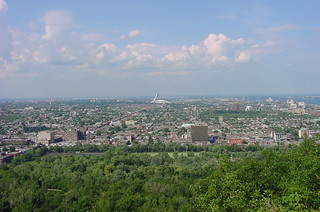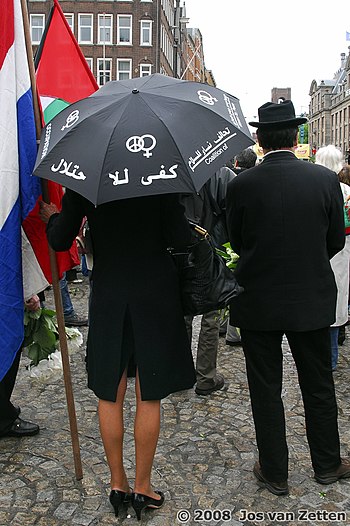| Montreal (Photo credit: Kristian20) |
| Reading (Photo credit: emilybean) |
| English: Roadside billboard of Deng Xiaoping in front of the city government of Qingdao (Photo credit: Wikipedia) |
The
runaway, ever-changing technology of the twenty-first century is out of the
control of the human beings who have invented it, who themselves have not
changed in their basic characteristics for 50,000 years. This is the chilling
conclusion that must be drawn from the stimulating, provoking film, Surviving Progress, first released in
2011, but re-screened this week to a mostly student audience by Cinema Politica
McGill.
The film
was made by a Montreal team of producers and directors, two of whom, Mathieu
Roy and Harold Crooks, the co-directors who devoted six years to making the
film, appeared after last night’s screening to be cross-examined by the student
audience.These two men who appear to be completely au fait with what is happening in the modern world, gave generously
of their time, but were unable to sound other than extremely worried (not to
mention depressed) about our prospects of recovering from the present
disastrous trend of the human race to eat ourselves out of house and home, and
were certainly unable to satisfy the demand of at least some of the students
for an uplifting, positive and hopeful ending.
This film
is “inspired by” the 2004 book, A Short
History of Progress, by Ronald Wright, a book that created such a stir when
published that it won all sorts of awards, was transferred into the Massey
lectures and created a sound basis for what seems to be the growing interest of
people around the world in thinking about our problems from a global, rather
than local, point of view.
Wright dealt
with ancient civilizations and their collapse, which he said were caused when
their inhabitants ran through their available natural resources. He wrote: “The lesson I read in the past is this: that the health
of land and water – and of woods, which are the keepers of water – can be the
only lasting basis for any civilization’s survival and success.”
We all
know that we are not heeding this warning, but instead are destroying the very
air, water and ecosystems on which our survival depends in the long term.
It is not
mentioned in the film, but a similar message was delivered in 1986 by the
globally-respected McGill archeologist and anthropologist Bruce Trigger, who in a
lecture on archeology and the future , said we have entered a phase in human existence
dominated by technology, that our current institutions and attitudes are
incapable of dealing with the major issues, and that what would be required were
the very qualities practised by paleo-hunters millenia ago --- such as
tolerance, sharing, foresight, and the ability to participate in social groups
and collective action.
This was
prophetic, to judge by the lineup of “brilliant minds,” (as Mathieu Roy
described them last night) who spoke in the film --- at least 20 of them from around
the world and from every relevant scientific discipline.
They were
interspersed with some wonderful images. In fact, the film’s opening was
unforgettable: a huge chimpanzee with its baby came through a trapdoor into a
small room where it tried to balance two simple L-shaped objects, one of which
was skewed so that it would not stand up unless reversed. First of all, the
image of these animals, their closeness to human beings, was rivetting: but
when they failed to realise that they could have stood both objects up simply
by turning the recalcitrant one upside down, the filmmakers were able to make
an important point. One of their interlocutors, Daniel Povinelli, a Louisiana-based
behavioural scientist, said this
experiment indicated that only the human
animal had ever had the capacity to ask, why? And it was this capacity that led on to
modern technology. The next image was of
a man walking in space as he worked on his space-station.
Some in the
audience were obviously unhappy that the film was not more solutions-oriented,
that it did not go into detail about how to solve the more urgent problems, like
how to save the Amazon rainforest from destruction, or how to accommodate the
growing demand of more than a billon Chinese that they should reach the level
of consumption, and the standard of living of Western populations. One of the men who spoke, Vaclav Smil, a Czech-born, Manitoba-based population scientist, said quite bluntly,”It
is unlikely that the world can support one billion more people at the level of
consumption of the United States.”
But there
is no doubt that is what the Chinese are trying to do, and we are in no
position, morally, to tell them to slow down, having done the same thing
ourselves in the past.
Victor
Gao, American-educated director the China Association of International Studies,
rammed the point home by saying that from 1840 until 1978, China had suffered
humiliation at the hands of other countries, when, he said, Deng Xiaoping
had put the country on “the right path”
towards capitalism (a questionable conclusion, in my opinion.)
Much of
the argument and explication was about debt and how it has been accumulated,
the facts being that as countries were unable to pay even the interest on their
Western-borrowed debts, so they found they had paid off far more than the
original loan, but all of it in interest payments, none of it in capital, a
treadmill to destruction.
(One of
the few illustrations drawn from the past in this film showed that ancient
Rome, when it got into debt, was one of the few civilizations that did not
cancel its debts; instead it invaded, stripped and destroyed its neighbours until
the Roman civilization itself collapsed under its own environmental destruction.
One of the
implications of making this sort of globe-embracing film is that it leaves
large areas of importance out of the reckoning. Or, perhaps to put it another
way, it begs its audience to go further. Two areas that struck me were that of
education: I felt like asking if the producers did not think we had too much
education, which could have stimulated a probing debate on a different but
related subject.
Also
politics was virtually unexamined, only Ronald Reagan and George W. Bush having
been chosen to deliver a clip of their notably short-sighted view of the world.
The
conclusion in the film leaned heavily towards a moral resurgence of some kind, as
an imposition into the current state of greed, consumption and faith in market forces,
emphasizing the importance of a moral dimension that has disappeared as
religions (for all the noise they make) have ceased to dominate the way the
world is moving.
As readers
can see, all these are big questions.
To my
mind, we are lucky to have people like Roy and Crooks who are concerned about
these questions, and are willing to spend their time in opening young minds to
alternative worlds.







